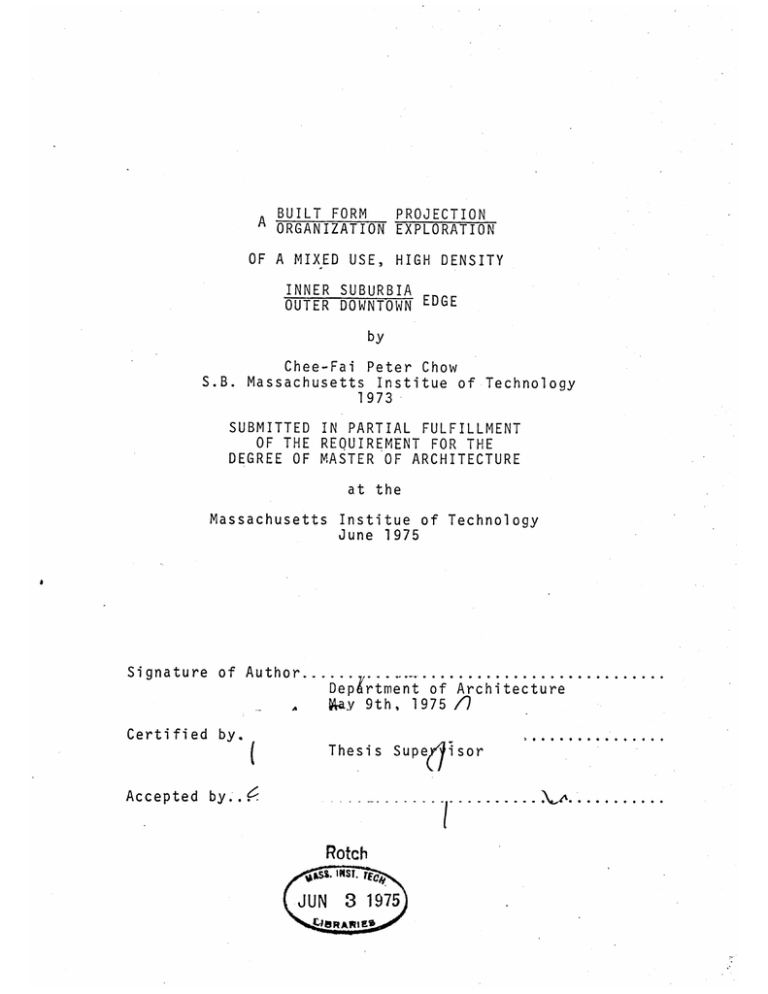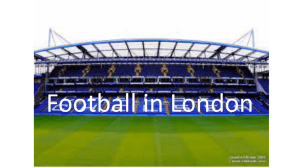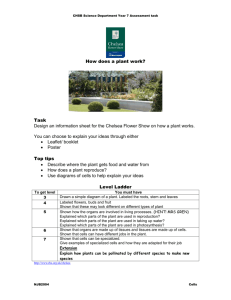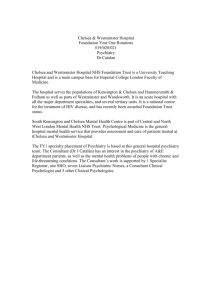Chee-Fai Peter Chow
advertisement

BUILT FORM
PROJECTION
A ORGANIZATION EXPLORATION
OF A MIXED USE, HIGH DENSITY
INNER SUBURBIA
OUTER DOWNTOWN EDGE
by
Chee-Fai Peter Chow
S.B. Massachusetts Institue of Technology
1973 SUBMITTED IN PARTIAL FULFILLMENT
OF THE REQUIREMENT FOR THE
DEGREE OF MASTER OF ARCHITECTURE
at the
Massachusetts Institue of Technology
June 1975
Signature of Author..
Dep rtment of Architecture
Kay 9th, 1975 /
Certified by.
Thesis Supedisor
Accepted by..
----- ---.
Rotch
4SI. NST . 17
JUN 3 1975
114BRANtES
.
ACKNOWLEDGEMENT
I would like to extend thanks
the following who have helped me
with my -thesis, either directly
or indirectly, constructively or
nonconstructively.
JGA
MA
IH
JK
VL
EM
MO
CS
RT
MU
EW
BZ
TITLE:
Built Form
Projection
.
A Organization'Exploration of a Mixed Use, High Density
Inner Suburia
Outer Downtown Edge
NAME OF AUTHOR:
Chee-Fai Peter Chow
Submitted to the Department of Architecture on May 9th, 1975
in partial fulfillment of the requirements for
the degree of Master of Architecture.
ABSTRACT
The initial intention of this thesis
was to explore middle-density housing
in an urban context- in this case, the
Chelsea Naval Hospital Site.
As it
turned out, the thesis consists of two
parts.
The first part deals with the
growth of the city of Chelsea onto the
naval hospital site and establishing a
use pattern for that growth (e.g. roads,
pedestian streets, open spaces, commerical,
private, public and institutionsl uses).
The second part of the thesis involves
the design. of approximately 100 units of
low and mid-rise housing within the
pattern already established for the site.
THESIS SUPERVISOR:
Richard Tremaglio
Associate Professor of Architecture
CONTENT
Introduction to
the Problem
1
Continuation...
5
The New Program
7
The Background
The City
The Site
Soil
Existing Buildings
Environmental Factors
Access
9
9
10
11
11
12
13
Illustrations
City of Chelsea Map
Existing Site Map
Slopes Map
Site Characterizatics
New Networks
Diagram I
Diagram II
Diagram III
Diagram IV
Use Map
Diagram A
Diagram B
Diagram Va
Diagram Vb
Plan: -10'
Plan: +5'
Plan: +20'
Plan: +70'
Section: A-A
Section: B-B
Section:. C-C
Section: D-D
14
15
16
17
18
19
20
21
22
23
24
25
26
27
.28
29
30
31
32
33
34
35
Bibliography
Appendix
36
INTRODUCTION
TO THE
PROBLEM
In the Spring of 1973, the United
States Naval Hospital at Chelsea,
Massachusetts was closed after 138
years of service.
This occurred as
part of a large-scale operation
closing hundreds of military installations
throughout the United States.
Under the
General Services Administration's surplus
property disposal procedures, the 88 acre
site has been offered to the city of
Chel sea.
There are several alternatives open to
the city of Chelsea, the first is to buy
the property from GSA and resell it to
private developers for tax-generating
uses.
Since the city's basic goal for
the site is to generate increased
municipal revenues, the emphasis on private
development of high-yield uses would seem
to be indicated.
However, if the city
commits itself to public use of the site,
it may receive the property at a considerable
discount.
A third alternative is to
combine public and private uses,
As a
final alternative, the city may simply
decline the offer altogether and leave
the disposition of the site to a private
developer to GSA.
Then, of course, the
city can only hope that GSA will accept
its recommendations for the development
most beneficial to Chelsea.
In order t0 decide on the best possible
alternativ e
the city of Chelsea hired
the firm o f Justin Gray Associates of
Cambridge, Massachusetts to study the
possible reuses of the naval hospital
site.
The study team analyzed the site
and met wi th city officials and private
citizens t 0 explore public needs.
developed a preliminary list
They
of appropriate
public and private uses and analyzed the
market for private uses and the programmatic and funding support for the public
uses.
Finally, the study team was able
to draw up a list of devel opment alternatives and a recommendati on for a preferred
alternative.
1n June,
1974, the Jus.ttn GrAy AssociAtes'k
report came out with five alternatives
for the reuse of the site.
terms they are:
In general
residential development,
industrial development, corporate headquarters, sports stadium complex and
public use package.
The study team felt,
however, that the public use package would
not actually be an alternative to the
other uses, but rather a group of uses
which could be houses in some of the
historical and existing buildings on the
site and not interfere with the private
development of the rest of the site.
The preferred alternative recommended by
the JGA study team was that of residential
housing program for one and two person
households using conventional mortage
financing. :.This was expected to generate
the highest level of income an.d other
benefits to the city but market analysis
showed that, at today's interest rates,
no one could afford to move into such
housing.
The residential development alternative
was then reworked based on financing by
the.Massachusetts Housing Finance Agency.
Under MHFA guidelines, 25 percent of the
proposed 1200 units would be subsidized
for low-income families.(See appendix
for JGA's program.)
Included in the residential development
would be a package of amenities including
recreation facilities, security and
transportation service to Boston.
Also
recommended by the study team would be
support commercial facilities, a HotelMotel,
a Conference Center, a marina
and several restaurants.
However, the
development is basicly to be a selfcontained environment.
CONTINUATION...
I worked on the thesis using the materials
from the JGA's report as the basic background work.
I looked at-the organization
of the site interms of JGA's program and
assumptions and decided that JGA's basic
approaches (kinds of housing, the organization of the housing as well as their
relationship to the city)
were incorrect
if the site is to be successfully interI
grated into the fabric of Chelsea.
must say here that my attitude was that
a piece of land as large and as valuable
as the Chelsea Naval Hospital Site should
not be looked upon as being separate
from the rest of the city.
Thus, I dropped the JGA program entirely
(except for the idea that the site was
to be used primary as residential) and
instead tried to deal With the site
interms of growth potential for the
city of Chelsea.
I started to establish
some of the use patterns that would
continue the pattern of the city.
One of
the consideration for that was the Chelsea
fire area (20 blocks destroyed in the
1973 and 1974 fire) is next to CNHS
and that HUD has already considered
putting some housing on part of that burned
out area.
Not knowing how to begin
attacking the problem I used the size
of the present unit of residential
organization (the block) and looked
at how within that block different uses
are organized.
I tried to use some of
the information from the analysis as
well as taking in the particular site
conditions.
However, because the initial goal was
to explore middle density housing in
an urban context it became.important to
me that part of the site was designed,
in one sense, to test the established
pattern.
THE NEW PROGRAM
Because I dropped the JGA program it was
important that a "new" program be developed
inorder to begin to plan the site in any
meaningful way.
According to 1970 census, the city of
Chelsea has a population of approximately
30,639 and the total land area of the city
is 1626 acres (including CNHS-88 acres).
Interms of the hospital site this means
approximate 2000 people or approximately
700 units of housing plus institutional,
commerical and recreational uses.
After going over the chapter in JGA's
report on community needs I came to the
following institutional and recreational
uses.
Medical Facilities:
Blood Research La-boratory- 20,0004- existing
Dental Clinic- 5,000+
Health Clinic
School Facilities:
Adminstrative Offices-14,0004
Vocational High School
Recreational Facilities:
Gymnasium- existing
Swimming Pool- existing
Thus the program would be the above plus
approximate 700 units of housing and
some commeridal uses.
The major assumption was that since this
site is to be a major portion of Chelsea,
the city would take care of its transportation, electrical, sewage and other
needs as it would any other part of the
city.
note
The information for the *new", program
came from JGAs report.
THE BACKGROUND
The City
Chelsea is the smallest city (in area)
in Massachusetts, covering 2.5 square
miles.
In the 1970 census, the population
was 30,639 and studies showed that the
population has remained fairly stable
for the past decade.
Of the city's 1626 acres, 21% is used
as industrial and only 21.8% is used as
residential.
Vacant land is minimal-
with the exception of the CNHS and the
burned out area.
Only 2,5% of the land
is used for recreational purposed and
with no public access to the water4,
In 1970, the figure showed 20% of the
population is over 60 and that the
median age is 32 years of age versus
29 for the metropolitan area.
Median
income was $8,973, approximately
$2,500 below the median income of
Metropolitan Boston.
Only 41% of the
population over 25 years old had at
least a high school education compare
to 65% in the metropolitan area.(Chelsea
has not built a new school since 1910.)
Interms of municipal facilities, as quoted
from the JGA report, "serious defeciencies
exist in virtually every aspect of
municipal service delivery."*
In short, Chelsea's desire to use the CNHS
to generate revenue is understandable.
On
the other hand, the city also has grea
needs (and perhaps even responsibiliti
*JGA Report
Volume I, Page 18
to provide an increase of its social
and recreational facilities to its cit izens.
The Site
The CNHS is located on the south-western
corner of Chelsea.
It is surrounded on
three side by the Mystic River.
Most
of the site consist of a hill with the
total difference of top and bottom elevation
of approximately 100 feet.
The Tobin Bridge
(1-93) goes over the eastern edge of the
site, virtually cutting the site off from
the city.
The north-western edge of the
site borders on some light industries
and the north,!Eastern edge borders on
residential areas.
The 1973-1974 burned-
out area is three blocks north of the
site.
Soil
The hill is a drumlin composed of sand,
gravel and silt.
Bedrock may occur
irregularly interms of distance from
the surface, therefore high-rise structures
can be supported with conventional
construction methods at any elevation.
The flat, low-lying portions of the site
are composed of fill over underlaying
layers of clay, silt or peat.
Because
of these conditions, construction might
require piling or caissons.
Existing Buildings
It is assumed that most of the 56 buildings
currently on the site will be removed due
to their possibilities for reuse.
There
are five buildings on the site with the
status of historical buildings that can
not be destroyed.
They are:
commandant's
office -(9,484#), nurses quarters (54,475#,
the first naval hospital building), magazine
storeage house (20,732 ), storehouse (9570),
and enlisted men's barracks (58-,180+,
the original marine hospital).
These
five buildings, in addition to a few
others could be used for long-term
community uses such as a nursing home,
a vocational high school or recreational
facilities.
Environmental Factors
One of the major environmental factor
to be taken into consideration is noise,
mainly from Boston's Logan Airport but
also from the Tobin Bridge over the Mystic
River.
In regard to the airport (takeoffs
and landinas using runway 15-33 fly over
the hospital site), on an average day,
approximately 100 takeoffs and 33 landings
use runway 15-33, about one-third of which
occur during the night.
This noise level
is in a category of definition by HUD as
discretionary-normally unacceptable (exceeds
65 db[A] 8 hours per 24 hours).
This
requires the approval of the HUD regional
administrator if federal funds are to be
used.
As a result of the flight patterns over
the site, buildings on top of the slope
cannot be built ove r 10-12 stories.
Also, the method of construction would
have to be masonry inorder to insure
lower Pioise level i nside the buildings.
Noise from the Tobin Bridge is not really
a major factor except within a distance
of 100 feet.
Access
Although access from the site to downtown
Boston and Logan Airport is easily accomplished,
there appears to be a problem of access in
and out of the site.
However, that problem
will exist only as long as one thinks of
the site as a separate section of Chelsea,
thus needing entrances and exits.
However,
if one takes the point of view that this
site is a continuation of the existing
fabric of Chelsea, the problem becomes
less: serious.
note
The above informations came from JGA's report,
AIL
MM:asnn
-
O
In7
06Ms
too
m
--. -
--
*~~IT
*/-
--
ACT
7
*...-.-.*.-.-.
-.. . . . . . . . ...-.
----
-
.
-
-
/
/
2
/
=~~ 0-3 %
3~ 5-8
II
/5
- 50
%
!b
TR1
'7
mr-w
NE TWORIK
THt NEW NLTWOPK 15 TWO
NEW
CON NtCTm 7m
'oenb ovT
H
7WO LOW.S OMER T1M", PM~
-EXl6TlNG ROADS
G$J:zD OFCITYI
0%.0
%0lb
DIAG RAM I
'THE
EXINUM6~ FM=
I) QI
]
4
i
4w
-j1
~
r
-
rr-- -*
*L 9-5
i
?k.ATe
A
V..rv/Caevco
A
*
tj
WHON Tft
LI-b"
p
r
%WdcyeAd
TOM
?JAgALWLTo
of~- buor
Ca*AjCAL.
WOVON OMMV4~c.L_
%1oW.
TMIT:
94OWC
(I~,TN~f~c
fto
P P (To
1W.A*" -~
eWcW4L &.nLpPd*g, WWOO5 u'
WI'PN IAL
~I33f'b-,
ft"6PI@6j TAKIR Or
7TM
Ara
AL6NJ61
, IT ,4LAfl;T
4IA7Mj~ 3LEfI4WM
ILO Wb VI m ap
900TP.
MAJ.ML
$4e**oLrodp
*.
SPNT
MAy.&STUOT.
AumAyTh
A. P~ V4W
or 703 RAOCK,
Arm4
~
Cea$BL.
AT A
W -*M
r
WhOUSASb Ter-
14OW.tU~
1IJ9., OVThUAS,
14*%Kt"
up' -ME
"'4.C.: 1) MAJOIL
STIMTSW
AOJOK dAOW*
IMTWL"t lr , 790
4 nv
rAW4-
SCP*VS
*WN
DIMGRAM
THE NEW FAMUC ELLIMTEKfATIN OF THI 1XISTIMS6
1W?R4XLVA l Wl5 TO FINAt
4OMItAT7bAL UNIT
THAT 15 Or A UA'jaAbLP
te. A tom
hTIT " LW ~IOWU414 7K A "AtolMmiDlY " C*K SOMAL " A~TiW) -To
Pr AT
7W-sAME T~ e ASa- mNu*H THAT IT
CMAM~J.WrrN i O& t4t~..rr,.
'IW0.
HAftf
0j*A
M
fT 46WS MfIT tiE MOTi-00100S, 91M THAT I CAN Il-M 4) lawOr- ter lp or"A erT1' fta'c.
IN4 CHOW-AN
(At
IIMTlof Z
X Soo-) ATAMT WuRepJIO 7*u VIf IT#WMm ft Ti1OUDW
or .6
0 a 4k" IO mC6m ritsiV'I4. c sm
PVi4WA7.1.)
TI4II T1 WTIN'
OF i*
l~ty F6F. Tie
SPOAL-
CMP4Irb,45 OF 110:
MAak APT" (C K- D~Am m).
,o
Pop"
'f bjpT MP T
-MPVAL- WvIlTAT.
AS, IIAJ5Tk~lMA
-oTh
T*Kv
51M -SAd'WWL4AS WITM
[
7r
TAT
mm m
i-'
lip
~JL~~~JWWWL
ILIIIZiiJm
jFZIZZ2 Ill
]9~3
I
vPsCPUP
PUMI THAT I
rm1r1F~
www
P]~
U
To Ov5KLA'(THE
ASOTtACTW
t
W T
I 0MIUAPNAL
T*.%
UNrr( tE
~
ASUWE
PIMI).
MSGK&" x
TIDE OGANNZAT!ONAL UNIT or
THE MU
-momM
/
NeHOT F190P 18$
flm 0-AAcit
ow Ammon-
-s
-awe"
~~PP4
I'
V&D
CAN P0 fWIL, 146T19A4
APPM V - VOVP4PIN(-j OtileTAVCWAK c,IOWc OrrW4- 9'M?ntomm
4 m mm
m mm
M InMIS or w wb
Uourft
AAJR
43pd
i-W...
rpWATO
VWX.4% fftiOIIAL
4
MW, f.
-4rt
5"'AN,AftpoW9IJ4
PIAirtAKI.).
OAMC
C'6011
HOWINW,
~AS,
WITH
ARP PiMA4OIoNSP
AAMMOd&
gAATS.
*of
ME
3M4fIe4* VPmPNN
fk"DTtV
WAY
4 mmmin~
hE:
014
I
'I
Com4cv~a4.
V
mminm
~
m
I
1
I
~A)*. ~
XAGKR TV
PMTS-. APTMOF
WAU'ft.OF TI4t TO#~Cr
Of IN Mwis AL. APPJiswiofDhe 7*w4 eIt4 spIE. 11gm
TW' or'
,m
w
IL
m
AO n
Mh
m
.a
s.m3
Mo #A9*"Tu.
ff",-p
ru
it-
4mq -
-
m
m - -
m - m
m
mmI w owI,.mgo
'leer.-r
?wI'1
- ----
--
t4.
b'm
rwu 0
iLJNSUr.~1
j
i/H
yr
U'
PORN VOK
I
I
I
.1
22.
\
USE MAP
To0%
A TObE XM.IZI
W* MIUM
m
ftNO
Aft ItiPWTD. WIN THEM104O
?MDETMu4 5TRIEI THE~ UNt AKE
TOft
ONGA)NIZU VATH rfS E14MD 6TWtIj
00 THE ?NVAr
VPMvt WAY.
* AKK(1r6 TOft DOMKM~~WW
MOYM
mtw~
l 5TNST MK'*Q
*LMPIF#4/ MVI&A
-,p
MD'ILL,
If
Wow
"Mo1NTIA
mt'f44
900OM4pChi.
4904M.
RMMIA
AOO
11
/
/
,
I
A4&
C0AVI
zo
A"~
AYS1c,
?Iic.
U.
TI
I
OA.
oit 1R
A..tq4AIA If
.& 3?
S'I
M
L- I A
P'TnW OAW 0~~~
-wlieeqAA
ToNo~d
AM
po weV
OFlie vii&
R
-
ti7
*f
-'
..
I
eA
J
4a
V
a01
I)GRA$ Y a.
*
AtP$. t~
1~
4-
ANl ATOFT$P 'TO PIMPD A
4KOW CAPP 'tOaThm) Iirr A
NA101 WLAPI PIMO,4,er- C0o.
-YO 'NKO649-'I
.~
UNDVWM. TH15 tMAWg. PIMPD45IOI
4.
MOwP4 t#hjtow Mg WOMAIRIP
II
RATTM
-
ZJ~TAL
'I
,,t~
*
,
..
4-.
M~A~iT
At'rz
~
f*
AwewJI.
I3"co I1m
ii TT)mIVA"~i
I
CAUP
AWN5- 5LU. MAWP
OR huDLE LO00~9
Tflp DUAUIdI
1AIM
:OPOO
- 15Dr
-TM
Ii
TVb foiND aF MMM.
II
f4*
I*
WIA1AL DW*ATIM
-K
>
A
"Zo9 m. NO"
wDoV IPU
31AIIAL
(NbT At,&,
J Wlk)
- lemcftfk
At4.
DI~GRA~ Y~
V
*~tc~i
t
4-
.7Lot
lDYfI~J~
i~WkI- w~,
u~v
AS ~'I~II
N~or ?AIL{
IF Ml]Jk
ts
ph~r ov
WAY TAWO
2.7
4
PLAN:
710,
mKROCWO,
NWOW
Am*p
A,
1"f9
'C
~Ji4
AU~AP"4
PLAN:
fl~'
ye
-r-
--
4'
..
iL2
i
*
-.
a-
-
g
g
a
TL
*
*
1~
* jm-*
L
S..
* *1
'I_
--
A
-1
fMKD(~
(4~
4
Afr
M41'/f
,ef
AL
f
'PLAN:
~tJ
Lu
,
'V
~1
~~-.20
~AS~
~4-~
,7~
I.
~' 2*
,w..
t
t I'
II
,j'
1
v
0W
'1
Ab~
(
PLAN
+70
*,-
-.
~
r- -r
(~.
a
eep
a
.3
SECTION
AA
Aj~f
J
.1
r
.
, -
1
b a32.
MI
11 0,
11-
SECTION
BB
71,
~ILL
lb
g
0
tiA
ff9;
.ef P
SECTON
OC
V
1~~
~=-.,
4L
-
*1
I6
0
U2
SECTION
.D-D
r
r
Ij~~L
Ii
~1.
J
"fgwiw
BIBLIOGRAPHY
Alexander,' Christopher
A Pattern Lanquage which generates
Multi-Service Centers
Center for Environmental Structure
Berkeley, California 1968
Audin, Marshall
A Projection for a Public Framework
Acessible to Wheel chair Users
Thesis, Master of Architecture
M.I.T. 1974
Gray, Justin (Architects and Planners )
A New Direction.Recommended for the
Re-Use of the Chelsea Naval Hosipital
Chelsea, MassachusettsPrepared for the City of Chelsea
June, 1974
Lynch, Kevin
Site Planning
M.I.T. Press
Cambridge, Massachusetts 1971
N.Y.S. Urban Development Corpora tion
and the Institue for Architectur e
and Urban Studies
Lovi-Rise, Hioh-Density-UDC/IAUS
Public Assisted Housing
Progressive Architecture
December, 1973
Rudofsky, Bernard
Streets for People, A Primer for Americans
Doubleday and Company , Inc.
Garden City, New York
Zevin, Barry
Built Form Exploration on an Urban Edge
Thesis, Master of Architecture
M.I.T. 1973
APPENDIX
All pages from
A New Direction Recommended for the
Re-Use of the Chelsea Naval Hospital
Prepared for the City of Chelsea
Volume I, June 1974
by
Justin Gray and Associates
Cambridge, Massachusetts
O - Minor Advantage
A - Major Problem
A
- Minor Problem
- Neutral Impact
TABLE 5
POTENTIAL MARKET USES FOR CHELSEA NAVAL HOSPITAL SITE:
U S E S
Location
in
Chelsea
Noise
INDUSTRIAL
Light
marine
Heavy
COMMERCIAL
Community or
Regional Shopping
Center
Office:
Speculative
Space
Institution:
Corporate hdqtrs
w/ R&D
RESIDENTIAL
1&2 person hslds
Family
OTHER
Motel/Hotel
Conference Center
Restaurant
Marina
Sports Stadium Complex
SITE ANALYSIS
P R O B L E M S
Competition
with
Historic
Buildings
Naval Yard
Access*
A
A
A
Glare
Odor
A
A
A
A
A
A
0 assuming coordination w/
renewal land
A
A
A
A
CONSIDERED INAPPROPRIATE DUE TO NUISANCE FACTOR
A
Relation to
Adjacent
Uses
A
Could be used
A
A
.A
A
A
A
A
A
A
A
A
A
A
A
A
A
A
A
A
A
A
A
A
A
A
A
A
A
A
A
A
A
A
A
A
A
A
AA
AA
A
A
A
0
0
A
*Highly dependent on detailed characteristics of specific uses.
A
A
A
A
TABLE 5 (Continued)
U S E S
P O T E N T I A L S
INDUSTRIAL
Light
Waterfront
Security
Accessibility
0 Advantage
0 Advantage
A Lost
Topography
A with respect
to use of
entire site
A
0
Marine
0
Heavy
CONSIDERED INAPPROPRIATE DUE TO NUISANCE FACTOR
COMMERCIAL
Community or
Regional Shopping
Center
Office:
Speculative
Space
Offset by closeness
to downtown Boston
Offset by closeness
to downtown Boston
Institution:
Corporate hdqtrs
w/
0
A
View
A
0
A
0
A
0
00
0
Visibility
0
0
0
A
A
R&D
RESIDENTIAL
l&2 person hslds
Family
0
0
0
0
0
0
0
0
0
0
0
0
0
0
0
0
0
0
0
0
0
OTHER
Motel/Hotel
0
0
0
Conference Center
Restaurant
Marina
Sports Stadium Complex
0
0
0
0
0
0
0
0
0
00
0
A Hard to use
0
TABLE 23
BELOW MARKET PROGRAM:
Dwelling Units/
Gross Acre
Product
Town Houses
Rent
Garden
Apartments
Mid-Rise
No. of Bedrooms/
Unit
Sq. Feet/
Unit
Total
Units
Units
Acres
Utilized
utilized
8
BR
BR
BR
BR
BR
30
60
10
10
10
Units
Units
Units
Units
Units
750
950-1,100
1,300
1,300
1,700
120
15-
12 & 18
BR
BR
BR
BR
BR
BR
90
150
225
15
15
15
Units
Units
Units
Units
Units
Units
500
750
950-1,100
1,300
1,500
1,700
510
28.3
BR
BR
BR
BR
80 Units
80'Units
300 Units
40 Units
500
750
950-1,100
1,300
500
12.5
1,120
55.8
40
TOTAL
SOURCE:
CHELSEA NAVAL HOSPITAL SITE
Justin Gray Associates
0
1
2
3
e)
Amenities and Related Uses for a Residential
Development
In order to meet the requirement that the residential development be part of a total environment, amenities
and other related uses must be provided on the site. The
site must be developed in such a manner that it is viewed as
a fine place to be, whether or not one lives there. Proposed, in addition to the standard amenity package of clubhouse, pools, sauna, putting green, games area, studio for
mid-rise/garden apartments and singles, are:
Amenities:
Indoor Tennis Courts: an indoor tennis court of
20,000 square feet should be provided on the site.
It should be a commercial venture, with costs distributed to its users, not to the residents generally.
Other Uses:
Commercial:
1,200 units can be expected to create
a market for approximately 17,800 square feet of
commercial space, distributed as follows:
Facility
Sq. Ft.
Barber
600
Cleaner, laundry, shoe repair
1,200
Gift
2,000
Liquor
2,000
Bank
2,000
General store, food, ice cream, etc. 10,000
17,800
f)
Related Uses:
Restaurants
Conference Center/Hotel-Motel/Marina/
Conference Center:
There is a major need in the Boston Metropolitan
Area for a Conference Center (see Technical SuppleThis center differs from a convention
ment Two).
facility. It is designed for training programs in
which people come to the Center for a period of
several days or weeks, not for short-term one- or twoday meetings. It requires a location and facility
which meet the following criteria:
(1) Close proximity to a major city and airport
(2) Few outside distractions in the immediate
area
(3) Excellent recreational facilities for the
limited free time of the participants
(4) Superior meeting and conference room facilities
(5) Superior audio-visual and meeting aid
equipment
(6) Good food and service in a relaxed and informal atmosphere
Clearly, the Chelsea Naval Hospital site meets criCriteria (4) and (5) are part
teria (1) and (2).
of the development program for such a Conference
Center. And Criteria (3) and (6) are amenities and
related uses that will be developed as part of the
residential package, particularly the garden and
mid-rise apartments.
Proposed is a 200-room Conference Center for the
site with 100 units being constructed in the first
phase, concurrent with the first phase of residential construction. The conference building contains
approximately 75,000 square feet to be built at a
construction cost averaging $40 per square foot.
Total development costs are estimated at $63.33 per
square foot. First-phase parking requirements are
for 100-150 spaces. The center will require three
acres of land with another three acres held in reserve. Located on the waterfront, it may be so designed as to incorporate the original Naval Hospital, designed by Bulfinch, and the commandant's house.
Hotel/Motel:
Another special market opportunity, resulting from
the site's special locational advantages, is for a
hotel-motel oriented toward airline and airportrelated personnel. Commercial airlines currently
contract with downtown hotels for rooms for transient personnel spending the night in Boston. The'
Naval Hospital site offers a first-class opportunity
to develop a hotel-motel aimed at serving these personnel:
the market, in this case, is guaranteed.
A total of 100 rooms are proposed with.50 constructed in the first increment. Estimated cost
is $25 per square foot for approximately 22,000
square feet of building space. An estimated 50
parking spaces will be required. Total land demands are therefore estimated in the vicinity of
35,000-40,000 square feet for the first increment
and 70,000-80,000 square feet in all.
Marina:
The Chelsea Yacht Club is one of the oldest in the
metropolitan area. The water off the Naval Hospital
site is currently one of the few locations in the
Inner Harbor where small boats can be moored.
Marinas are currently proposed for Charlestown,
East Boston, and, of course, Harbor Towers. The
closeness of the Chelsea Naval Hospital site to
downtown should give a marina developed there a
real competitive edge. Proposed is a 100-slip
marina,.with each slip estimated to cost approximately $8,000, for a total cost of $800,000, plus
an additional $20,000 for a small marine gasoline
station/marine hardware store. Required sanitary
pumping stations for a marina of this size will be
an additional cost.
Restaurants:
The combination of 1,200 units of housing, a Conference Center, a hotel-motel, and a marina should
create the market for two restaurants and one cocktail lounge. The first restaurant would be small,
oriented primarily to the conferees at the Conference Center but open to the public. Though no
market study was done for the second restaurant,
it is estimated that it should contain a range of
100 to 200 seats and a cocktail lounge-discotheque
seating a range of 100 to 150 persons. Its market
potential consists of residents of the housing on
the site, people using the Conference Center,
guests at the hotel-motel and marina, and others
attracted to the site. Approximately 100 parking
places may be required and a total estimated land
area of 50,000-60,000 square feet.
g)
Conclusions:
Residential Program
This development package of 1,200 units of housing, a first-phase 100-room Conference Center, a first-phase
50-room hotel-motel, a 100-slip marina, and two restaurants
provides the basis for the design of a total environment for
the Chelsea Naval Hospital site. Each use supports and enhances the other. Amenities can be shared. -The waterfront
becomes an opportunity for recreation. The site's unique
topography and view will help to shape this unusual development which can provide the best housing for one- and twoperson households in the Boston Metropolitan Area, at the
same time making a substantial contribution toward meeting
the housing needs of Chelsea residents.
Its staging also creates immediate opportunities for a
marketable environment. Proposed first-stage construction
would include the town houses, the Conference Center/hotelmotel/marina/restaurants, 100 garden apartments and 250 midrise apartments.
For both the first phase and the total project, adequate
transportation to both downtown Boston and the airport will
be essential. During the first phase, bus system service
will be provided to downtown and the airport. Once the project passes its half-way point, it is proposed to establish
a boat connection to the Aquarium station on the Blue Line
at Atlantic Avenue.
h)
The Financing of Market-Rate Housing
The market program outlined of 100 town houses with
their own patio, 200 garden apartments, 500 mid-rise apartments, and 400 singles units is aimed at meeting the demand
of one- and two-person households. Seven hundred units, the
garden apartments and the mid-rise apartments, have as their
target- those households currently attracted to such developments as Granada Highlands. The 100 town house units are
aimed at those households who want their own house with open
space, and the 400 singles units at those households who are
attracted by this special housing type.




